- Health Conditions A-Z
- Health & Wellness
- Nutrition
- Fitness
- Health News
- Ayurveda
- Videos
- Medicine A-Z
- Parenting
- Web Stories
NASA Astronaut Sunita Williams’ Health Deteriorates During Extended Mission: Experts Raise Concerns

There is a rising concern about NASA astronaut Sunita William's health after her eight-day mission to the International Space Station (ISS) was extended for six months. The delay was due to a Starliner spacecraft problem that prevented her and fellow astronaut Barry Wilmore from reaching home on time. Doctors are concerned about the effect of her extended vacation on her physical condition, as her return date is set for February.
Weight Loss and Nutritional Deficiencies in Space
Recent photos of Williams reveal significant weight loss. What is most visible are her sunken cheekbones, raising worries about her eating habits. There are speculations of her being on a calorie-deficit diet. This could mean that she ate less than her body required to sustain the high energy needs of space travel.
Astronauts in microgravity must exercise for 2.5 hours daily to maintain muscle and bone health, but the challenging environment can still lead to weight loss, as their bodies expend extra energy adapting to the lack of gravity and maintaining body heat.
Long Wait for Return with the Dragon Capsule
The predicament is exacerbated by a delay in the return car. The crew is now likely to be rescued by Elon Musk's Dragon capsule in February, some months later than anticipated. While experts do not see any immediate risk, they doubt if Williams' current physical state can be sustained for a lengthy term. The lack of fresh food and limited calorie-dense options aboard the ISS may jeopardise her capacity to maintain proper nutrition.
Long Wait for Return with the Dragon Capsule
The predicament is exacerbated by a delay in the return car. The crew is now likely to be rescued by Elon Musk's Dragon capsule in February, some months later than anticipated. While doctors do not believe Williams is in imminent danger, they are unconvinced that his current physical state can be sustained in the long run. The lack of fresh food and limited calorie-dense options on the ISS may jeopardise her capacity to maintain appropriate nutrition.
Health Concerns Highlighted by Crew-8 Hospitalisation
Williams' condition follows another health worry for long-duration astronauts. On November 5, four Crew-8 astronauts—Matthew Dominick, Michael Barratt, Jeanette Epps, and Alexander Grebenkin—were sent for medical review after more than 200 days on the International Space Station. They arrived in Florida on October 25 via the SpaceX Dragon spaceship and appeared to be in good health. However, as a precaution, NASA chose to hospitalize one crew member overnight, while all astronauts received extensive health screenings.
Keep track of the health concerns associated with long-duration spaceflight
NASA suppressed precise details of the Crew-8 medical tests because of privacy concerns, but stated that the procedures were undertaken "out of an abundance of caution." The health concerns connected with long-duration space missions are well established, with difficulties such as muscular atrophy, bone density loss, and potential dietary deficiencies jeopardising astronauts' health upon return. These preventive approaches highlight the importance of ongoing research and careful health monitoring for astronauts on long-term missions.
Ongoing Health Monitoring in space Exploration
As longer missions become the norm, organizations such as NASA prioritise health concerns in order to mitigate the risks associated with prolonged space exposure. Regular exercise, limited meals, and post-mission medical checks are critical for astronauts' health. As space exploration progresses, astronauts' safety on these risky flights becomes more critical for future space missions.
IV Drip, COVID-19 Shot And Ozempic: How Different Injections Enter The Body In Different Ways
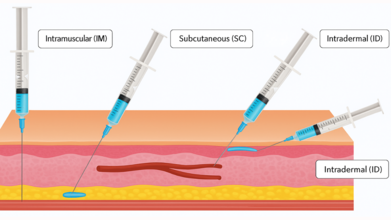
Credits: Canva and AI generated
Injections are one of the most direct and effective ways to deliver medications, nutrients, or fluids into the body. Unlike oral medicines, which must first pass through the digestive system, injections allow a substance to enter the bloodstream, muscle, or tissue directly, leading to faster or more controlled absorption.
There are several types of injections, but four are most widely used in healthcare practice: intravenous, intramuscular, subcutaneous, and intraosseous. Each has its own purpose, method, and site of administration.
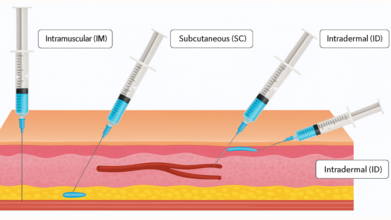
Intravenous (IV) Injections
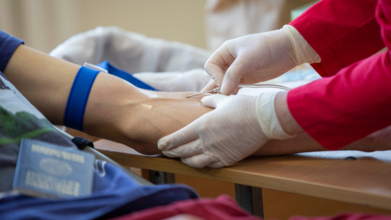
Intravenous injections deliver medication straight into a vein, allowing for rapid absorption and immediate action. Because the bloodstream is accessed directly, this type of injection is considered the fastest way to introduce drugs or fluids into the body.
Common Uses
IV injections or infusions are frequently used in:
- Providing fluids and electrolytes to treat dehydration
- Administering local or general anesthesia before surgery
- Delivering pain relief medications in emergency rooms
- Blood transfusions and iron supplementation
- Nutrition for severely malnourished patients
- Chemotherapy for cancer treatment
- Monoclonal antibodies for infections such as COVID-19
- Injecting contrast dye before imaging tests
Sites of Injection
Typical IV sites include veins on the back of the hands, forearms, or inside the elbow. In infants, doctors may use veins on the scalp or feet.
Intramuscular (IM) Injections
Intramuscular injections deliver medication into the muscle tissue, which has a rich blood supply that helps the drug absorb quickly, as noted by the Centers for Disease Control and Prevention, (CDC) guidelines.
Common Uses
- Most vaccines, such as flu shots
- Antibiotics like penicillin or streptomycin
- Corticosteroids for inflammation or allergic reactions
- Hormones such as testosterone or medroxyprogesterone
- Medications for patients unable to take oral drugs
Sites of Injection
Healthcare professionals usually administer IM shots in:
- The upper outer thigh muscle
- The deltoid (shoulder) muscle
- The hip area
Doctors generally avoid injecting into the buttock due to the risk of damaging the sciatic nerve.
Subcutaneous (SC) Injections

Subcutaneous injections are given into the fatty tissue just beneath the skin and above the muscle. They use a smaller needle to ensure the medication enters the fatty layer rather than muscle tissue. Unlike muscles, fatty tissue contains fewer blood vessels, which means the body absorbs medication more slowly—making it useful for drugs that require steady, prolonged release.
Common Uses
- Insulin for diabetes management
- Blood thinners like heparin
- Vaccines such as MMR (measles, mumps, rubella) and chickenpox
- Pain control medications in palliative care (e.g., morphine, fentanyl)
- Fertility medications and biologics such as Dupixent
Sites of Injection
Typical SC injection sites include:
- The outer or back part of the upper arm
- The front or outer side of the thigh
- The belly (at least a few centimeters away from the navel)
Subcutaneous injections are relatively less painful and carry a lower risk of infection. They are often preferred for patients who need to self-administer medication at home, such as those managing diabetes.
Intraosseous (IO) Injections
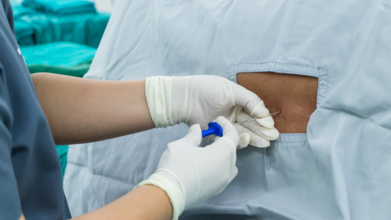
Intraosseous injections are less common but extremely valuable in emergency medicine. They involve puncturing the bone marrow with a specialized needle to deliver drugs or fluids directly into the rich blood supply of the marrow. Since the marrow connects directly to the circulatory system, this method is fast and effective when IV access is difficult.
Common Uses
IO injections are usually reserved for critical emergencies such as:
- Cardiac arrest
- Severe trauma or accident injuries
- Overdose or poisoning
- Sepsis or septic shock
- Stroke or seizures
- Obstetric complications (e.g., childbirth emergencies)
They can also be used to administer anesthesia in dental procedures or deliver palliative care pain relief when veins are inaccessible.
Sites of Injection
Common IO access points include:
- The shinbone (tibia)
- The thigh bone (femur)
- The upper arm bone (humerus)
Risks and Side Effects
While injections are generally safe when performed by trained professionals, there are some risks. The CDC notes that common side effects include temporary pain, redness, swelling, or bruising at the injection site. Rare but serious risks may involve nerve damage, abscess formation, bleeding, or infection. Safe handling of needles and proper technique are critical to minimizing complications.
The Bizarre Foot Test That Could Point Towards A Heart Failure
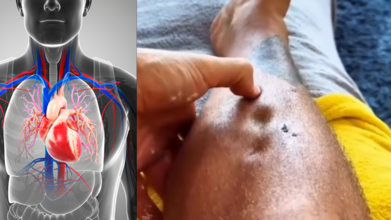
Credits: Canva and Instagram
Thanks to Instagram and other such social media platforms, we know a lot about our health than before. In a video, a person presses on his lower leg, and instead of the skin bouncing back smoothly, it shows small pit-like impressions. The caption on the video reads: A Visible Sign Of Congestive Heart Failure.
A throbbing dorsalis pedis pulse, the artery running along the top of the foot, might appear harmless at first glance. However, doctors caution that such a finding can be an important clinical sign, often linked to conditions such as peripheral vascular changes or fluid overload. In particular, it may reflect elevated central venous pressure (CVP), a common feature of congestive heart failure (CHF).
Medical experts recommend that whenever this sign is seen, it should not be dismissed. Instead, patients should be assessed thoroughly, including checking bilateral pulses, looking for swelling in the legs or feet, and correlating these observations with blood pressure and a full cardiac examination.
Understanding Congestive Heart Failure
Congestive heart failure, also called simply heart failure, is a long-term condition where the heart cannot pump blood efficiently enough to meet the body’s needs. While the heart is still beating, it struggles to keep up with circulation demands. As a result, blood builds up in other parts of the body, most often in the lungs, legs, and feet.
Doctors often describe it with a relatable analogy: imagine a shipping department that is constantly behind schedule. Packages pile up because they cannot be dispatched on time. Similarly, in heart failure, fluid “packages” accumulate in the body, leading to symptoms and complications.
Different Types of Heart Failure
Heart failure is not a one-size-fits-all condition. It has different forms:
- Left-sided heart failure, where the left ventricle struggles to pump blood effectively.
- Right-sided heart failure, which often results from long-standing left-sided failure and leads to blood backing up in veins.
- High-output heart failure, a rare type where the heart pumps normally but the body demands more blood than it can provide.
- Right-sided heart failure is particularly linked to distended veins and visible pulsations, as seen in cases where fluid overload is present.
How Widespread Is the Problem?
Heart failure is alarmingly common. In the United States alone, more than six million people live with the condition, making it the leading cause of hospitalization among those older than 65. With aging populations and rising lifestyle-related diseases such as diabetes and hypertension, the burden of CHF is expected to grow further.
Common Symptoms Of Heart Failure
CHF can manifest in many ways, some subtle and others unmistakable. Typical symptoms include:
- Shortness of breath, especially during activity or at night
- Chest pain and palpitations
- Fatigue and weakness
- Swelling in the ankles, legs, and abdomen
- Weight gain and frequent nighttime urination
- A persistent, dry cough or bloating in the stomach
Some patients may experience only mild discomfort, while others face severe, life-limiting symptoms. Importantly, the condition tends to worsen over time if not managed.
Causes and Risk Factors
Several factors contribute to the development of heart failure, including:
- Coronary artery disease and heart attacks
- Long-standing high blood pressure
- Cardiomyopathy, often due to genetics or viral infections
- Diabetes and kidney disease
- Obesity, tobacco use, alcohol, or recreational drug use
- Certain medications, such as chemotherapy drugs
Risk increases with age, sedentary lifestyle, poor diet, and family history of heart disease. Left-sided heart failure is the most common trigger for right-sided failure, but lung diseases and other organ issues can also play a role.
Potential Complications
Unchecked heart failure can lead to serious complications such as irregular heart rhythms, sudden cardiac arrest, valve damage, fluid buildup in the lungs, kidney or liver failure, and malnutrition. These risks make early recognition of clinical signs, such as visible dorsalis pedis pulsation, critically important.
Diagnosing Heart Failure
Doctors use a combination of medical history, physical examinations, and diagnostic tests to confirm CHF. They typically ask about family history, lifestyle habits, medication use, and other medical conditions. Key tests include echocardiograms, ECGs, chest X-rays, MRIs, CT scans, stress tests, and blood work. In some cases, genetic testing may also be used.
Stages of Heart Failure
Heart failure is classified into four stages (A to D):
Stage A: High risk but no symptoms, often due to conditions like hypertension or diabetes.
Stage B: Structural heart problems but no outward symptoms.
Stage C: Clear symptoms alongside a confirmed diagnosis.
Stage D: Advanced heart failure with severe, treatment-resistant symptoms.
Why Medication Abortion Remains The Most Common And Safe Choice Even In 2025?

Credits: Health and me
In 2023, medication abortion emerged as the most common form of abortion in the United States, reflecting both the convenience and accessibility it offers. With evolving policies, telemedicine provision, and the continued demand for privacy and safety, understanding when and how medical abortion is recommended has become more critical than ever. Abortion in the United States has long been a controversial topic, but the increasing patchwork of state laws has made medical abortion all the more difficult to monitor.
Unlike surgical abortions that take place in clinics, medical abortions tend to occur in private locations with pills prescribed or even ordered over the internet something that makes it difficult to collect data. Throw in the recent round of restrictions and court battles, and researchers, policymakers, and clinicians are left with a distressing void: we just don't know how many medical abortions are being performed, where they are being performed, or what this looks like for women's health.
Although surgical abortion continues as a necessary procedure for specific circumstances, the growth of medication abortion has revolutionized reproductive health care by providing a safe and non-invasive alternative for termination during early pregnancy. This change also highlights the need for proper information, safe access, and quality follow-up care to provide positive health outcomes.
Latest figures from the Guttmacher Institute bring to fore that in the majority of U.S. states with less stringent abortion laws, medication abortion had represented 63% of total procedures offered during 2023. In Wyoming, as an example, 95% abortions were medication-related, with 84% taking the same route in Montana.
Even telemedicine is coming into play: an estimated 10% of medication abortions were provided solely online in states where telemedicine bans did not exist, with some states up to 60%. These trends highlight the importance of preserving and continuing access to abortion pills as an essential part of reproductive health care.
What is A Medical Abortion?
Medical abortion is a non-surgical and non-invasive procedure to end an early pregnancy, usually between 4 and 9 weeks. It uses a two-drug combination: mifepristone, to block progesterone required for continuing the pregnancy, and then misoprostol, which causes uterine contractions to pass the pregnancy. Dr. Rupali Mishra, sonologist and physician at Dr Rupali's Abortion Centre, describes, "Medical abortion is advised if the pregnancy is ensured to be intrauterine and the patient is medically fit".
This involves factors such as lack of severe anemia, bleeding disorders, chronic asthma, or allergies to drugs. She reiterates that availability of follow-up care, such as ultrasound scans to exclude retained products of conception (RPOC), is fundamental to the safe outcome.
When Is Medical Abortion Recommended By The Physician?
Medical abortion is most effective in the early weeks of pregnancy. For pregnancies nine weeks or less, the procedure may frequently be carried out outside of hospital facilities by trained health-care practitioners like gynecologists, nurse-midwives, or certified midwives. However, beyond nine weeks, medical abortion is carried out in hospitals with medical care because risks become greater and complications may arise. "Medical abortion is a convenient and non-invasive procedure, hence suitable for patients who value such factors," remarks Dr. Mishra.
The eligibility criteria too are medically oriented. The patient should not have ectopic pregnancy, severe chronic illnesses of heart, kidney, or liver function, or known contraindications to the medication. Written informed consent is legally mandatory in registered MTP centers to confirm understanding and safety of the patient.
Procedure and Follow-Up Care
After administration, patients can suffer from abdominal cramps, pain, and bleeding for 15–20 days. In most instances, there are no complications, but excessive bleeding, severe pain, or incomplete abortion can lead to a suction evacuation procedure. A follow-up ultrasound after about three weeks confirms the uterus is clear, marking the success of the procedure. Dr. Mishra states, "Even with high success rates, routine follow-up is critical to manage potential complications such as infection, prolonged bleeding, or retained tissue."
Safety Precautions and Possible Side Effects
Medical abortion is normally safe, but improper use or self-administration under unsupervised conditions can prove fatal. Heavy bleeding, incomplete abortion, infection, or, in exceptional cases, shock caused by undiagnosed ectopic pregnancy are serious side effects. Dr. Mishra cautions, "Selling abortion pills over the counter without a prescription is illegal and very risky. Medical supervision is a non-negotiable factor to avoid severe complications."
Medical Abortion vs. Surgical Abortion
Knowing the distinction between surgical and medical abortion enables proper patient decision-making. Surgical abortion is instant and appropriate for later gestation or incomplete medical abortion, whereas medication abortion is non-surgical and appropriate for early pregnancy. Both need follow-up for completion assurance and checking for complications.
What Role Telemedicine Play In Successful and Safe Abortion?
Telemedicine has revolutionized access to medication abortion, especially in states with less-restrictive laws. Virtual consultations with trained providers enable patients to get prescriptions and instructions without face-to-face visits, providing greater privacy and ease. However, according to Isabel DoCampo of the Guttmacher Institute, legal safeguards and access need to keep evolving in order to provide safe provision across states.
Medical abortion is safe, effective and becoming increasingly prevalent for the ending of early pregnancy if under qualified medical care.
Eligibility, procedure, and follow-up must be explained to patients so that safety and health can be assured. As reproductive health policy continues to change, maintaining access to safe abortion care—including medication and telemedicine—remains paramount. Open dialogue with objective medical professionals, coupled with adequate support and counseling, continues to be imperative for enabling individuals to make responsible decisions regarding their reproductive well-being.
Disclaimer: This article is provided for informational purposes and is not medical or legal advice. Readers are urged to seek advice from qualified healthcare providers for medical advice and to consult state or federal authoritative resources for updates on the laws of abortion in the United States.
© 2024 Bennett, Coleman & Company Limited

